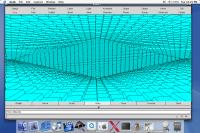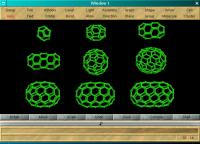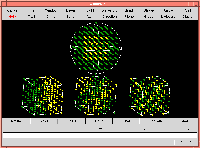
20 x 20 x 20 Wigner-Seitz cells for an Orthorhombic I lattice,
with 1.0, 3.0 and 3.1 lattice parameters, seen from the inside,
projected in perspective (the little dots inside are the nodes).
GAMGI is now running also on Mac OS X (10.1.2), thanks to the
Fink project. The window
manager seen here is
Blackbox. Size: 100,454 bytes.

Three transparent layers with different lights in a single image:
one layer with 10x10x2 conventional cells for an Hexagonal lattice
with parameters 1.0 and 1.633, plus one conventional, primitive and
Wigner-Seitz cells for an Orthorhombic I lattice, with lattice
parameters equal to 1.0, 3.0 and 3.1 and no lights, a second layer
with 3x3x3 Wigner-Seitz cells for a Cubic I lattice and a grey light,
plus a third layer with 3x3x3 Wigner-Seitz cells for a Cubic F
lattice with a greenish light. Both lights are directional, these
ones have only diffuse and ambient components. GAMGI running on
Yellow Dog GNU/Linux 2.2 on a PPC Titanium notebook, with
Enlightenment and the
marble GTK theme. Size: 82,911 bytes.

C
20, C
30, C
40, C
50, C
60,
C
70, C
80, C
90 and (you guessed...) C
100
fullerenes, drawn in solid mode, with a grey directional light.
The layer has an orthographic projection to emphasize the molecular
symmetry. GAMGI running on Yellow Dog GNU/Linux 2.2 on a PPC
Titanium notebook, with
Window Maker
and the marble GTK theme. Size: 56,104 bytes.

Occupancy pattern rules at work, here with Cubic P lattices.
Above, a cube of Si surrounded by C in a spherical volume:
C (___***, ___***, ___***); Si (*2_, *2_, *2_).
This is usefull for example in hidration studies, say,
a silica cluster surrounded by water molecules. Below,
5x5x5x5 Conventional cells: 1) C on the left and Si on the
right: C (*2_, *, *), Si (_2*, *, *); 2) alternating
octant cubes with C and Si: C (*2_, *2_, *2_), (_2*, _2*, *2_),
(_2*, *2_, _2*), (*2_, _2*, _2*), Si (*2_, *2_, _2*), (_2*, _2*, _2*),
(_2*, *2_, *2_), (*2_, _2*, *2_); 3) C alternating with Si:
C (*_, *_, *_), Si (_*, *_, *_). This is usefull for example
to study liquid mixtures, say, of molecules of water and ethanol.
Cells are shown with edge borders and orthographic projections
to reduce clutter. Image taken on a PC running GNU/Linux
Red Hat 5.2 with
AnotherLevel and
Lesstif.
Size: 11,063 bytes.
Screenshots for older releases can be found here.
 20 x 20 x 20 Wigner-Seitz cells for an Orthorhombic I lattice,
with 1.0, 3.0 and 3.1 lattice parameters, seen from the inside,
projected in perspective (the little dots inside are the nodes).
GAMGI is now running also on Mac OS X (10.1.2), thanks to the
Fink project. The window
manager seen here is
Blackbox. Size: 100,454 bytes.
20 x 20 x 20 Wigner-Seitz cells for an Orthorhombic I lattice,
with 1.0, 3.0 and 3.1 lattice parameters, seen from the inside,
projected in perspective (the little dots inside are the nodes).
GAMGI is now running also on Mac OS X (10.1.2), thanks to the
Fink project. The window
manager seen here is
Blackbox. Size: 100,454 bytes.
 Three transparent layers with different lights in a single image:
one layer with 10x10x2 conventional cells for an Hexagonal lattice
with parameters 1.0 and 1.633, plus one conventional, primitive and
Wigner-Seitz cells for an Orthorhombic I lattice, with lattice
parameters equal to 1.0, 3.0 and 3.1 and no lights, a second layer
with 3x3x3 Wigner-Seitz cells for a Cubic I lattice and a grey light,
plus a third layer with 3x3x3 Wigner-Seitz cells for a Cubic F
lattice with a greenish light. Both lights are directional, these
ones have only diffuse and ambient components. GAMGI running on
Yellow Dog GNU/Linux 2.2 on a PPC Titanium notebook, with
Enlightenment and the
marble GTK theme. Size: 82,911 bytes.
Three transparent layers with different lights in a single image:
one layer with 10x10x2 conventional cells for an Hexagonal lattice
with parameters 1.0 and 1.633, plus one conventional, primitive and
Wigner-Seitz cells for an Orthorhombic I lattice, with lattice
parameters equal to 1.0, 3.0 and 3.1 and no lights, a second layer
with 3x3x3 Wigner-Seitz cells for a Cubic I lattice and a grey light,
plus a third layer with 3x3x3 Wigner-Seitz cells for a Cubic F
lattice with a greenish light. Both lights are directional, these
ones have only diffuse and ambient components. GAMGI running on
Yellow Dog GNU/Linux 2.2 on a PPC Titanium notebook, with
Enlightenment and the
marble GTK theme. Size: 82,911 bytes.
 C20, C30, C40, C50, C60,
C70, C80, C90 and (you guessed...) C100
fullerenes, drawn in solid mode, with a grey directional light.
The layer has an orthographic projection to emphasize the molecular
symmetry. GAMGI running on Yellow Dog GNU/Linux 2.2 on a PPC
Titanium notebook, with Window Maker
and the marble GTK theme. Size: 56,104 bytes.
C20, C30, C40, C50, C60,
C70, C80, C90 and (you guessed...) C100
fullerenes, drawn in solid mode, with a grey directional light.
The layer has an orthographic projection to emphasize the molecular
symmetry. GAMGI running on Yellow Dog GNU/Linux 2.2 on a PPC
Titanium notebook, with Window Maker
and the marble GTK theme. Size: 56,104 bytes.
 Occupancy pattern rules at work, here with Cubic P lattices.
Above, a cube of Si surrounded by C in a spherical volume:
C (___***, ___***, ___***); Si (*2_, *2_, *2_).
This is usefull for example in hidration studies, say,
a silica cluster surrounded by water molecules. Below,
5x5x5x5 Conventional cells: 1) C on the left and Si on the
right: C (*2_, *, *), Si (_2*, *, *); 2) alternating
octant cubes with C and Si: C (*2_, *2_, *2_), (_2*, _2*, *2_),
(_2*, *2_, _2*), (*2_, _2*, _2*), Si (*2_, *2_, _2*), (_2*, _2*, _2*),
(_2*, *2_, *2_), (*2_, _2*, *2_); 3) C alternating with Si:
C (*_, *_, *_), Si (_*, *_, *_). This is usefull for example
to study liquid mixtures, say, of molecules of water and ethanol.
Cells are shown with edge borders and orthographic projections
to reduce clutter. Image taken on a PC running GNU/Linux
Red Hat 5.2 with
AnotherLevel and Lesstif.
Size: 11,063 bytes.
Occupancy pattern rules at work, here with Cubic P lattices.
Above, a cube of Si surrounded by C in a spherical volume:
C (___***, ___***, ___***); Si (*2_, *2_, *2_).
This is usefull for example in hidration studies, say,
a silica cluster surrounded by water molecules. Below,
5x5x5x5 Conventional cells: 1) C on the left and Si on the
right: C (*2_, *, *), Si (_2*, *, *); 2) alternating
octant cubes with C and Si: C (*2_, *2_, *2_), (_2*, _2*, *2_),
(_2*, *2_, _2*), (*2_, _2*, _2*), Si (*2_, *2_, _2*), (_2*, _2*, _2*),
(_2*, *2_, *2_), (*2_, _2*, *2_); 3) C alternating with Si:
C (*_, *_, *_), Si (_*, *_, *_). This is usefull for example
to study liquid mixtures, say, of molecules of water and ethanol.
Cells are shown with edge borders and orthographic projections
to reduce clutter. Image taken on a PC running GNU/Linux
Red Hat 5.2 with
AnotherLevel and Lesstif.
Size: 11,063 bytes.